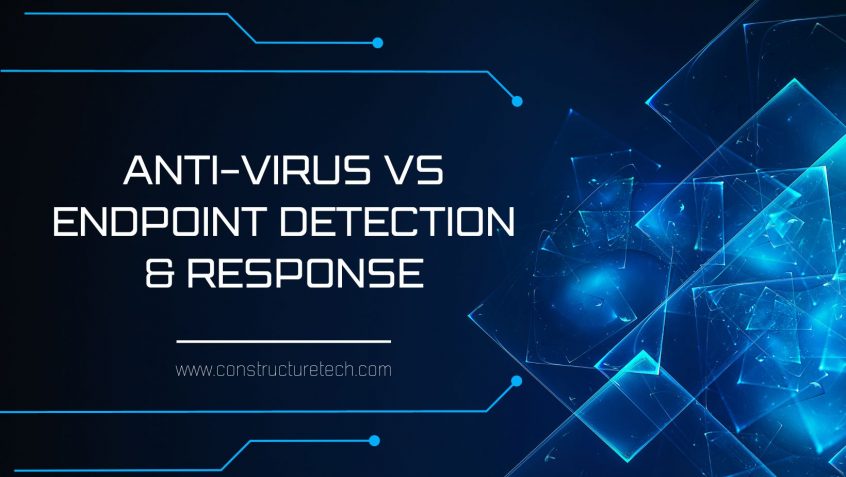In today’s digital world, the protection of personal data from online threats is of paramount importance. With the rising number of cyberattacks, having robust security measures in place has become essential. Two primary solutions commonly administered for this purpose are Anti-Virus (AV) and Endpoint Detection & Response (EDR).
This blog post will explain the differences between two cybersecurity approaches. These approaches are important for protecting against viruses, malware, and online threats.
What is Anti-Virus?
Anti-Virus (AV) is an application that finds and stops harmful programs, called malware, on computers and devices. Anti-Virus solutions protect computers from harmful operating systems like viruses, worms, Trojans, ransomware, and spyware, ensuring security and functionality.
AV scans files, apps, and data on a computer to find patterns or signatures linked to known malware. The Anti-Virus application performs actions when it finds a match. These actions include isolating, cleaning, or deleting the infected files. The purpose of these actions is to prevent any danger and ensure the safety of the user’s data and system.
Anti-Virus systems have gotten better over time. It has added features like real-time protection, behavior analysis, and cloud-based threat intelligence. These additions help it stay up to date with the ever-changing cyber threats.
Anti-Virus is crucial for cybersecurity. However, people often use it in conjunction with other tools. These tools include EDR and network security. The purpose of using these tools is to safeguard against cyber threats.
The Role of Anti-Virus in Cyber Security
- Virus Removal: Anti-Virus excels in efficiently removing viruses and malware from infected systems, preventing further damage.
- Real-Time Protection: Most AV solutions actively scan in real-time to detect and deal with threats as they occur.
- Anti-Virus protects against online threats by blocking malicious websites and phishing attacks.
- Endpoint Security: AV applications on devices are crucial for user or organization security.
What is Endpoint Detection & Response (EDR)?
Endpoint Detection and Response (EDR) is a cybersecurity method. It focuses on finding and dealing with complex threats. These threats occur on devices such as computers, laptops, smartphones, and tablets. A company implements EDR within its network.
Unlike traditional Anti-Virus systems, EDR operates in real-time, continuously monitoring endpoint devices for any unusual or suspicious activity. It applies behavior-based analysis to detect anomalies and potential threats, even if they lack known signatures. EDR helps security analysts find signs of compromise and discover threats that other security measures may have missed.
EDR provides detailed reports about security incidents. This data helps security teams understand the extent and impact of the attack. It also facilitates post-incident forensic analysis, helping organizations identify the root cause of the attack and develop effective mitigation strategies.
EDR can integrate with threat intelligence feeds, ensuring that the system stays updated with the latest data about emerging cyber threats. Some EDR solutions work in the cloud. This makes it easier to deploy and operate them. It also allows for scalability and centralized threat analysis and response.
Adding EDR to security tools enhances organizations’ ability to detect and respond to advanced and unknown threats promptly. This makes EDR an essential component of modern cybersecurity strategies.

The Role of Endpoint Detection & Response in Cybersecurity
- Threat Hunting: EDR solutions proactively search for suspicious activity within an organization’s network, identifying potential threats before they cause significant harm.
- Real-Time Response: Unlike traditional AV systems, EDR responds in real-time to contain and mitigate security incidents as they unfold.
- Advanced Persistent Threat (APT) Defense: EDR is highly effective against sophisticated and persistent attacks, providing enhanced protection against targeted threats.
- Cloud-Based Capabilities: Many EDR solutions operate in the cloud, facilitating easy deployment and centralized management.
Can EDR replace AV?
While Endpoint Detection & Response provides advanced threat detection and response capabilities, it does not entirely replace Anti-Virus. EDR and AV serve different purposes and are most effective when used together as complementary layers of protection.
EDR excels in identifying and responding to complex threats, including zero-day exploits and APTs. It offers deep visibility into endpoint activity, making it an invaluable tool for threat hunting and incident response. However, EDR may not be as efficient as AV in removing common malware or viruses quickly.
Anti-Virus is important because it scans for viruses, removes threats, and protects against malware and phishing attacks in real-time. By combining the strengths of both EDR and AV, organizations can create a robust cybersecurity strategy.
Why are AV and EDR important?
- Protects Personal Data: AV and EDR solutions keep personal data safe from cyber-attacks.
- Mitigating Online Threats: The combination of Anti-Virus and Endpoint Detection & Response ensures comprehensive protection against viruses, malware, and phishing attacks.
- Security: Protecting Android and iOS devices is crucial with the increasing use of smartphones and tablets. Antivirus (AV) and Endpoint Detection and Response (EDR) are essential for security against evolving cyber threats.
- Quick Response: EDR can quickly respond to threats, stopping data breaches and system compromises, helping organizations protect their data.
Is AV Enough? The Limitations of Anti-Virus in Modern Cybersecurity
While Anti-Virus (AV) detects known malware, evolving cyber threats challenge its effectiveness. AV relies on signatures, making it ineffective against zero-day exploits and polymorphic malware. It may also struggle with fileless malware and lack contextual understanding, leading to false positives or negatives. Furthermore, AV’s endpoint focus limits its visibility into broader network activity and may not detect advanced persistent threats (APTs).
To stay safe, organizations should use multiple security measures like EDR, Threat Intelligence, Behavior-based Analysis, and AV. By integrating these tools, organizations can better defend against a wide range of cyber threats and strengthen their overall cybersecurity strategy.
EDR: The Perfect Companion to AV for Comprehensive Cybersecurity
While Anti-Virus (AV) remains important, it’s not enough to counter today’s diverse cyber threats. Endpoint Detection & Response (EDR) works hand-in-hand with AV, filling the gaps and enhancing protection.
EDR detects advanced threats using behavior-based analysis, hunts for potential risks proactively, and responds in real-time. It provides deeper visibility, aids in APT defense, and facilitates incident analysis.
Organizations can strengthen their cybersecurity by using AV and EDR together. This helps protect against both known and new threats. It also ensures the safety of sensitive data and important assets.
Overall AV vs EDR
In conclusion, both Anti-Virus and Endpoint Detection & Response play crucial roles in safeguarding against viruses, malware, and online threats. Both are great antivirus solutions and help protect against malicious activity. Anti-Virus is good at scanning and removing viruses, while EDR detects and responds to advanced threats. They work well together for strong cybersecurity.
To keep personal data safe and stay ahead of changing threats, people and groups should use both AV and EDR. Thanks to these security measures, users can confidently browse the internet, download apps, and connect to Wi-Fi networks. These measures ensure the safety of their devices and data. Get yourself protected today.

